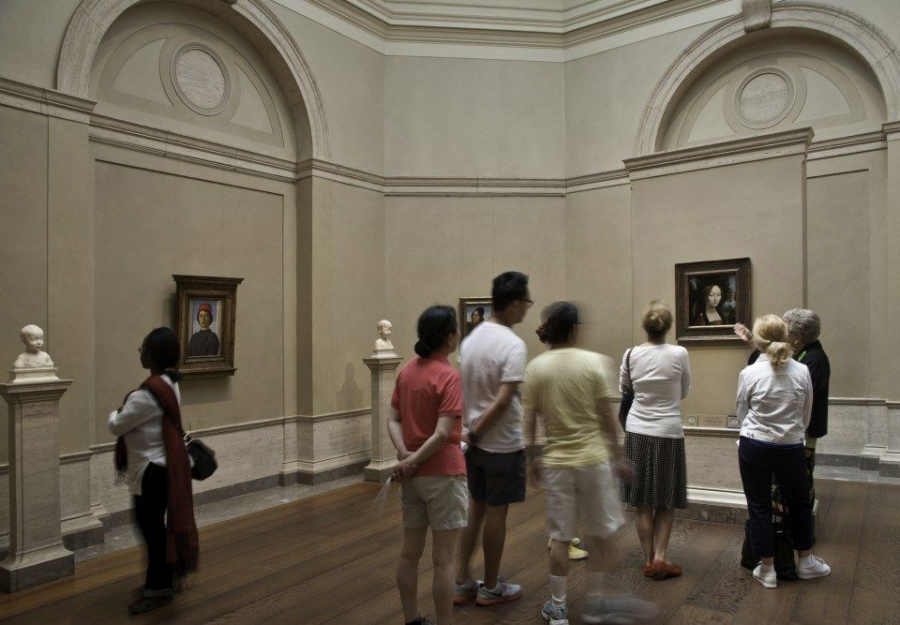Weddings are notoriously expensive. But what if yours was so expensive that you had to sell one of the most sought-after paintings in Europe to pay for it?
Welcome to the life of Liechtenstein’s royal family — in 1967, that is. Though the current prince of Liechtenstein is one of the wealthiest royals in Europe, World War II left the man who held the title for much of the 20th century, Franz Joseph II, with much less money to his name. When it came time to plan an elaborate wedding ceremony for his son, according to National Gallery of Art curator David Alan Brown, he couldn’t do so without selling one of the family’s many artistic treasures: Leonardo da Vinci’s “Ginevra de’ Benci,” a 15th-century portrait that museum curators had eyed for years.
“The painting really became famous as a work by Leonardo in the earlier part of the 20th century,” said Brown, who specializes in Italian and Spanish paintings. “It may be interesting that now, because the princes of Liechtenstein are so rich … they would never ever sell it.”
After many failed attempts, the National Gallery eventually bid the right amount at the right time and acquired what remains to this day the only Leonardo painting to be displayed in the Americas. Though Brown declined to divulge the exact price, the museum’s website lists a $5 million price tag — at the time, one of the highest sums ever paid for a painting. It was “the bargain of the century,” Brown said, “in view of the fact that Leonardo’s ‘Salvator Mundi’ was recently sold for $450 million” to a Saudi prince. (“Salvator Mundi,” which will end up in the Louvre Abu Dhabi, became “the most expensive painting ever sold at auction,” according to the auction house Christie’s.)
Unlike his prolific peers Bellini and Raphael, Leonardo painted fewer than 20 oil paintings throughout his career. Plenty of Leonardo’s sketches live on this side of the Atlantic, Brown said, but Europeans maintained such a tight grip on his paintings that even the wealthiest of American collectors couldn’t get their hands on any. Most hang in the Louvre or Florence’s Uffizi Gallery.
The American museum just got lucky.
“We call it the National Gallery’s Mona Lisa because it’s a portrait of a Florentine lady,” Brown said. “But it’s an early work, not a late one. As an early work, it shows all the promise of Leonardo’s later career without the mastery that he’d achieved by the time he came to paint the Mona Lisa.”
The portrait dates back to the 1470s, when Ginevra de’ Benci was the teenage daughter of a wealthy Florentine banker. Known to have had many admirers, according to Brown, she was celebrated because of both her braininess and a “platonic affair” with Venetian Ambassador Bernardo Bembo — the latter an odd phenomenon that proved to be quite common between ladies and gentlemen of the Renaissance era. Their mutual admiration inspired sonnets, just as her beauty inspired Leonardo.
On the painting’s reverse side is a painted wreath consisting of three plants: juniper, a play on Ginevra’s name; palm, a representation of moral virtue; and laurel, which symbolizes her artistic side. A scroll surrounds the wreath with a motto written on it: “Virtutem Forma Decorat,” or “beauty adorns virtue.” Leonardo painted Ginevra quite plainly but made sure to highlight her porcelain-like skin. Whereas most Florentine women were depicted indoors and in lavish garments, Ginevra appears in simple garb and without any jewels. She was “more of a poet than a clotheshorse,” Brown said.
After the Liechtenstein family parted with the painting, the National Gallery needed to find a way to transport it to Washington “without any fanfare,” according to Brown. They opted for what seemed to be the best solution: a climate-sealed American Tourister suitcase. A curator kept a close eye on the painting, which got its own plane seat.
“We might not do it exactly the same way today,” Brown said, “but the idea was to keep it as discreet as possible.”
The National Gallery also purchased a few other pieces from the Liechtenstein collection, the curator said, but “Ginevra de’ Benci” is the only one his team receives complaints about if it is ever taken down — even for reasons as practical as photography or technical examination. He added that a majority of museumgoers make sure to stop by the painting when they visit, which translates to about 5 million people each year.
“It is the most important painting in the best collection of Italian paintings in America,” Brown said, “so that’s saying a lot.”



